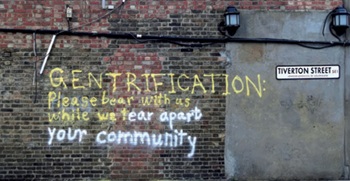Skeffington Report
The ground-breaking Skeffington Report, ‘People and Planning. Report of the Committee on Public Participation in Planning’ was prepared by Arthur Skeffington MP and the Ministry of Housing and Local Government. It was published by HMSO in 1969.
The Skeffington Committee was appointed in 1968 to assess how the public might become more involved in the creation of local development plans. This was a response to the belief that the Town and Country Planning Act created a largely ‘top down’ system, and followed the 1965 report ‘The Future of Development Plans’ prepared by the Planning Advisory Group.
Prior to this, public consultation had largely been a gesture only, involving the ‘usual suspects’, already familiar with the planning process and how to participate. At a time of slum clearances, town centre redevelopments and major road building programmes, this had resulted in poor community involvement and the emergence of a number of protest groups.
The Skeffington Report proposed that local development plans should be subject to full public scrutiny and debate. However, the recommendations of the report were not immediately taken up. They were seen as being rather vague and were misrepresented as simply advocating better public education and better communications so that it could be claimed planning decisions were well supported.
However, in the longer term, the principals that it set out became more widely accepted. Planners and developers have become more pro-active, and previously unrepresented and ‘hard to reach’ parts of society have become better engaged. This has begun to establish planning as a genuinely democratic process, involving mediation between a wide range of competing interests.
This culminated most recently in the introduction of the Localism Act and the emergence of policies such neighbourhood planning described by DCLG as, '...a new way for communities to decide the future of the places where they live and work'. Neighbourhood planning is intended to allow local communities:
- To influence where new developments should take place.
- To influence what new developments should look like.
- Under certain circumstances to grant planning permission.
However, the change is a gradual one, and even neighbourhood planning has attracted criticism for empowering a particular section of the community, already used to wielding power.
[edit] Related articles on Designing Buildings
Featured articles and news
Retrofit 25 – What's Stopping Us?
Exhibition Opens at The Building Centre.
Types of work to existing buildings
A simple circular economy wiki breakdown with further links.
A threat to the creativity that makes London special.
How can digital twins boost profitability within construction?
The smart construction dashboard, as-built data and site changes forming an accurate digital twin.
Unlocking surplus public defence land and more to speed up the delivery of housing.
The Planning and Infrastructure Bill
An outline of the bill with a mix of reactions on potential impacts from IHBC, CIEEM, CIC, ACE and EIC.
Farnborough College Unveils its Half-house for Sustainable Construction Training.
Spring Statement 2025 with reactions from industry
Confirming previously announced funding, and welfare changes amid adjusted growth forecast.
Scottish Government responds to Grenfell report
As fund for unsafe cladding assessments is launched.
CLC and BSR process map for HRB approvals
One of the initial outputs of their weekly BSR meetings.
Architects Academy at an insulation manufacturing facility
Programme of technical engagement for aspiring designers.
Building Safety Levy technical consultation response
Details of the planned levy now due in 2026.
Great British Energy install solar on school and NHS sites
200 schools and 200 NHS sites to get solar systems, as first project of the newly formed government initiative.
600 million for 60,000 more skilled construction workers
Announced by Treasury ahead of the Spring Statement.
The restoration of the novelist’s birthplace in Eastwood.
Life Critical Fire Safety External Wall System LCFS EWS
Breaking down what is meant by this now often used term.
PAC report on the Remediation of Dangerous Cladding
Recommendations on workforce, transparency, support, insurance, funding, fraud and mismanagement.
New towns, expanded settlements and housing delivery
Modular inquiry asks if new towns and expanded settlements are an effective means of delivering housing.
























